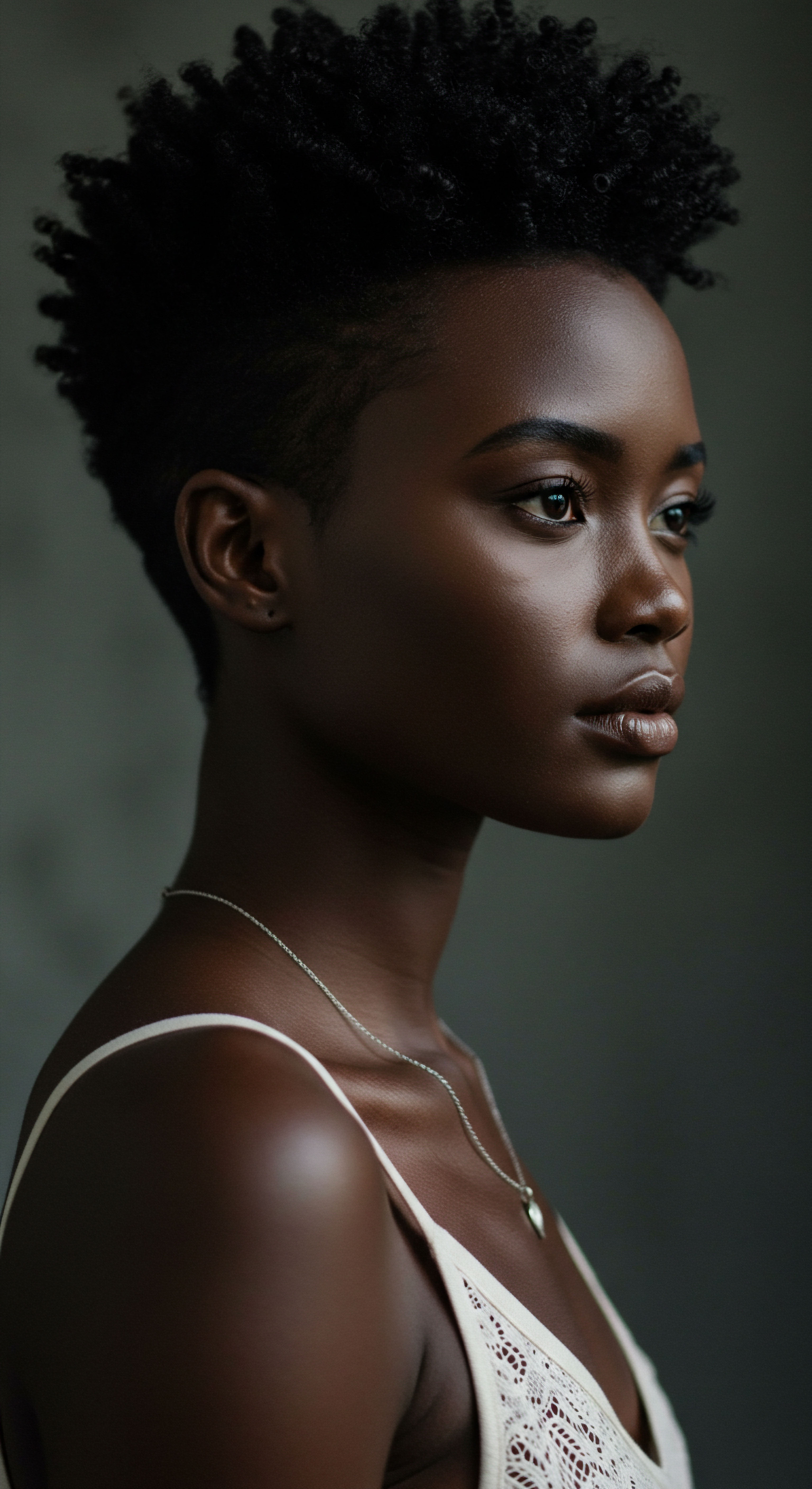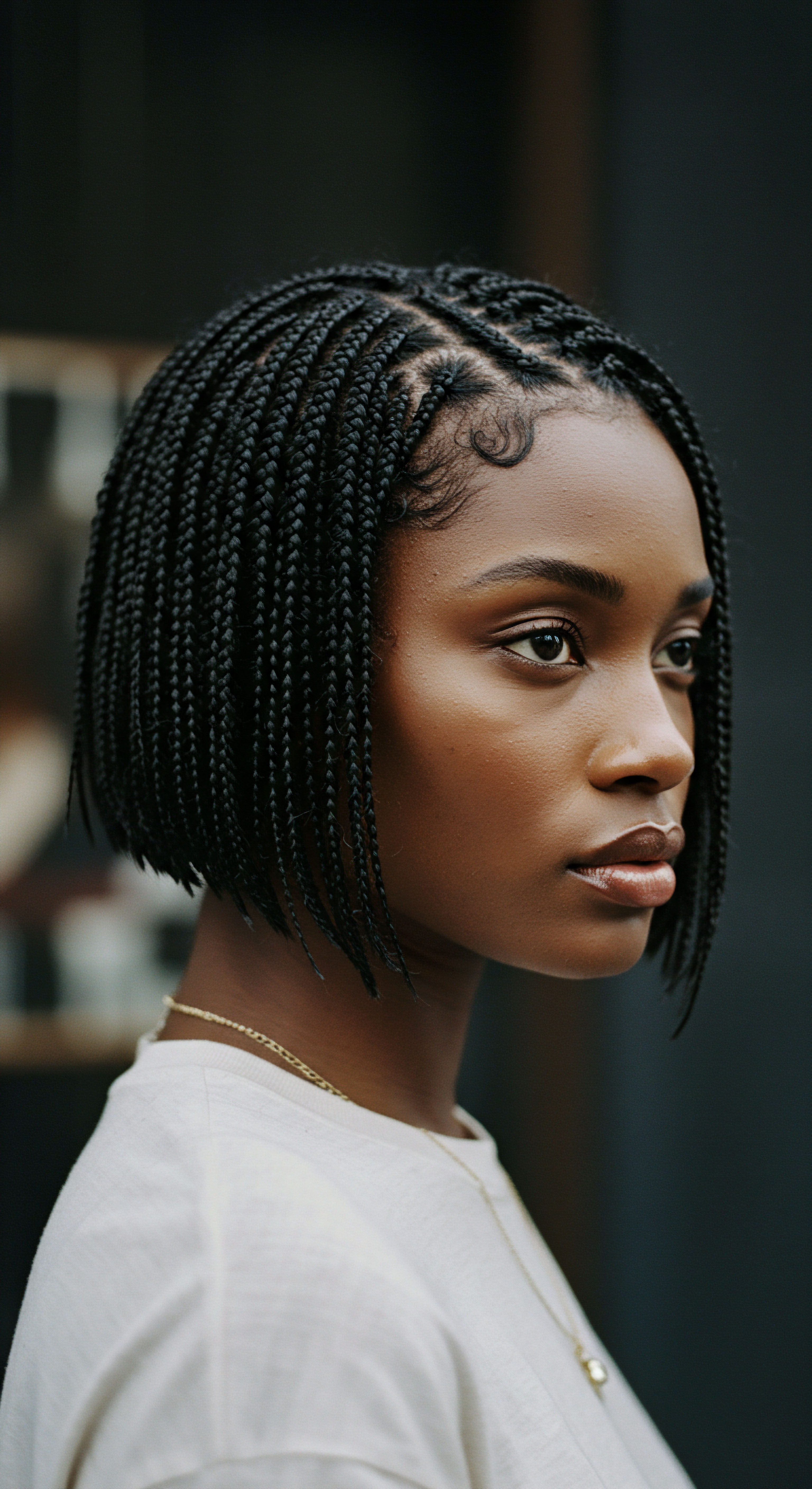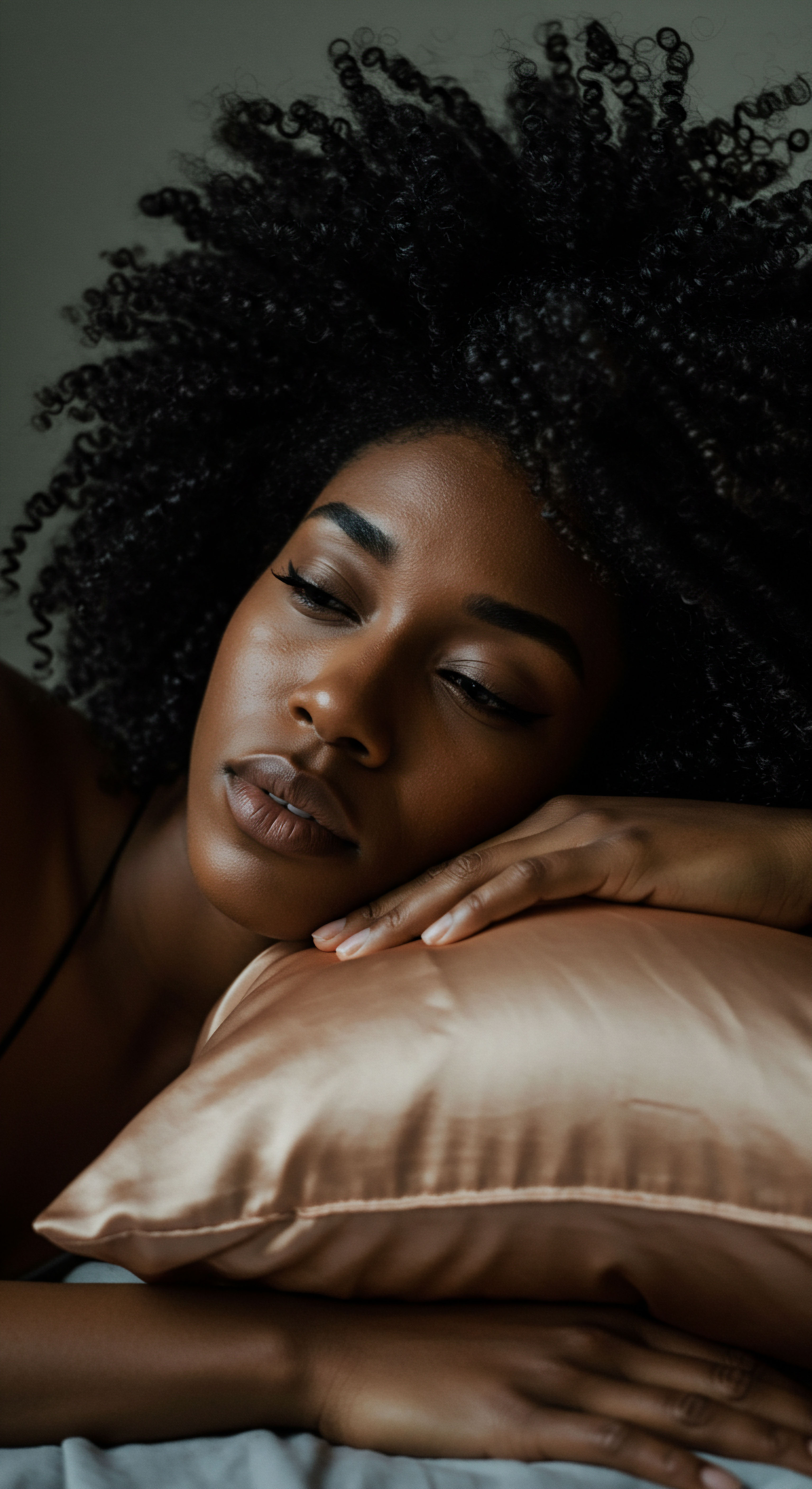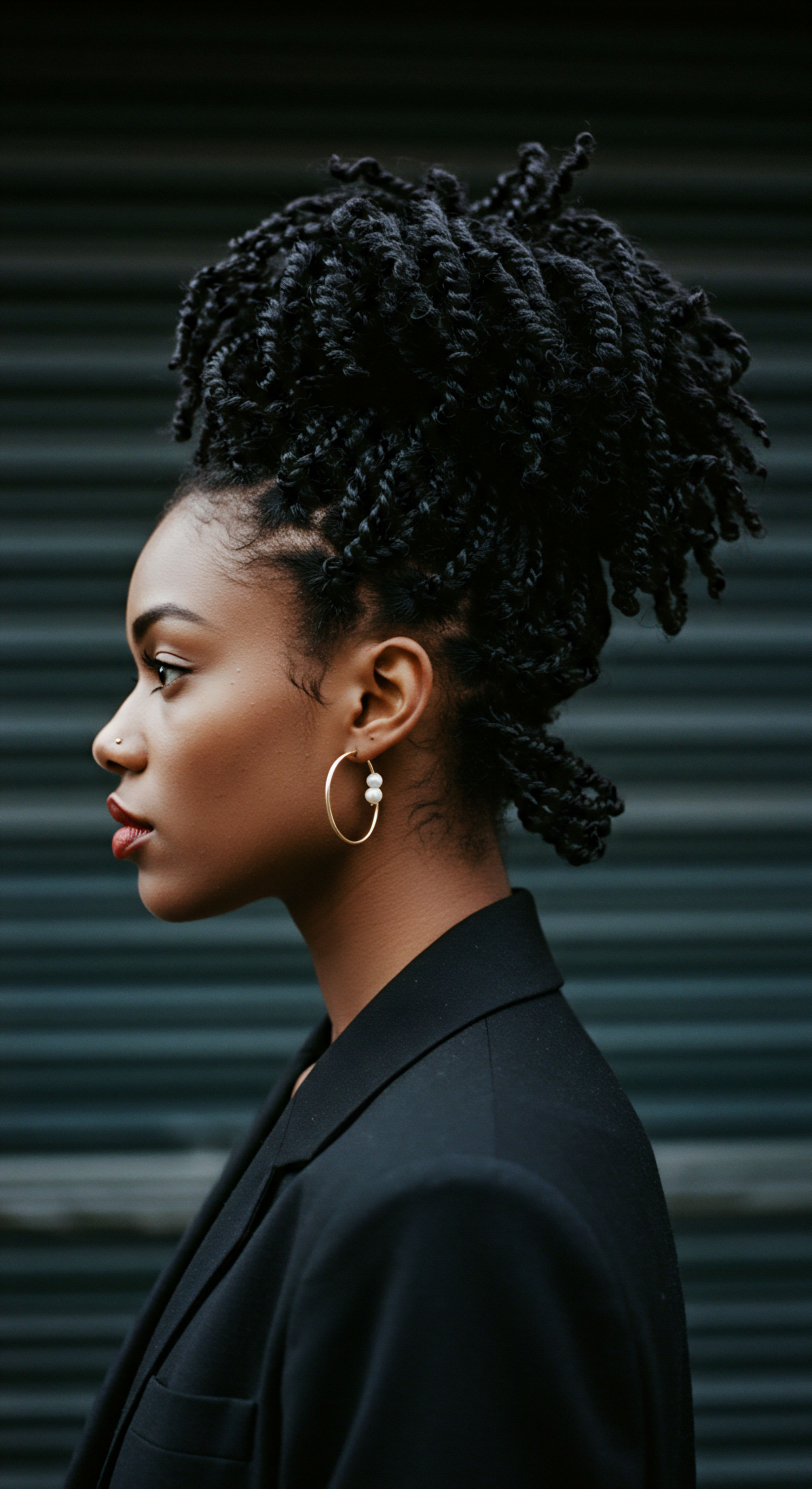
Roots
A quiet whisper in the world of textured hair often concerns the delicate dance of moisture, its ebb and flow, and the yearning for lasting hydration. We sense it, the way our coils and curls respond to the air, the gentle tug of a brush, the whisper of dryness. It is within this profound observation that we find ourselves drawn to silk, not merely as a luxurious fabric, but as a source of remarkable proteins that offer solace to thirsty strands. To truly appreciate silk’s capacity, we must first journey to the very core of a hair strand, understanding its intricate construction and how it interacts with the world around it.
Hair, at its heart, is a marvel of biological engineering, primarily composed of a fibrous protein called Keratin. This robust protein forms the structural backbone, providing strength and shape to each individual strand. The outermost layer, the cuticle, acts as a protective shield, comprising overlapping, scale-like cells. When these cuticular scales lie flat, they create a smooth surface, allowing light to reflect and moisture to remain within.
However, external factors such as heat styling, chemical treatments, and even daily manipulation can cause these scales to lift, leaving the hair vulnerable to moisture loss and damage. This inherent susceptibility, particularly pronounced in the varied contours of textured hair, underscores the continuous quest for ingredients that can offer a gentle, yet effective, hand in preserving hydration.

What Components Give Hair Its Structure?
The architectural precision of hair begins at the follicle, where cells multiply and keratinize, forming the distinct layers that characterize a hair strand. Beyond the cuticle, the cortex constitutes the bulk of the hair, composed of bundles of keratin fibers that give hair its strength and elasticity. The innermost layer, the medulla, is present in some hair types and appears as a central core.
The integrity of these layers dictates how well hair retains its internal moisture, a vital aspect for the vitality and resilience of textured hair. When the structural components are compromised, the hair’s ability to hold onto water diminishes, leading to dryness, brittleness, and a lack of suppleness.
Hair’s structural integrity, from its cuticle to its cortex, profoundly influences its ability to retain essential moisture.
The interaction between hair and water is a constant exchange. Hair is hygroscopic, meaning it readily absorbs water from the environment. However, the challenge lies in preventing this absorbed water from quickly escaping.
This is where ingredients that can create a lasting barrier or deeply bind water become invaluable. The molecular makeup of hair proteins, particularly their amino acid sequences, dictates their affinity for water molecules and their capacity to influence the hair’s hydration levels.

How Does Hair Respond to Environmental Humidity?
Hair’s response to environmental humidity is a complex interplay of its protein structure and the surrounding atmospheric conditions. In humid environments, hair tends to absorb water, which can cause the keratin structure to swell. For textured hair, this swelling can lead to a phenomenon often described as “frizz,” where individual strands expand and resist alignment. Conversely, in dry conditions, hair can rapidly lose its internal moisture to the atmosphere, becoming parched and brittle.
This constant adjustment highlights the need for external agents that can mediate this exchange, helping hair maintain a stable moisture balance regardless of the external climate. Understanding these fundamental principles of hair anatomy and its interaction with moisture sets the stage for appreciating how specific proteins, like those found in silk, can offer profound benefits.

Ritual
The daily and weekly practices we observe for our hair form a sacred ritual, a quiet conversation between self and strand. Within this realm of care, the inclusion of specific elements can elevate a routine from mere maintenance to a gesture of profound nourishment. When we speak of silk, its presence in hair care extends beyond the soft touch of a pillowcase; it finds its way into formulations designed to imbue hair with lasting moisture and a remarkable softness. The ritual of applying a silk-infused product is an act of gentle fortification, a step towards a more serene and supple head of hair.

What Forms of Silk Protein are Used in Hair Preparations?
Silk, in its raw state, consists of two primary proteins ❉ Fibroin and Sericin. Fibroin forms the core, providing strength, while sericin acts as a sticky outer layer, holding the silk filament together. For cosmetic applications, these proteins undergo a process called hydrolysis, which breaks them down into smaller, more manageable fragments—hydrolyzed silk protein, silk peptides, or silk amino acids. This reduction in molecular size is crucial, as smaller molecules possess a greater ability to penetrate the hair shaft, reaching beyond the outermost cuticle layer.
Larger fragments, conversely, tend to form a protective film on the hair’s surface, offering external conditioning and a smooth feel. The selection of hydrolyzed silk, therefore, depends on the desired effect ❉ deep conditioning and repair from within, or surface protection and sheen.
Hydrolyzed silk proteins, in their various molecular sizes, offer a dual benefit ❉ internal nourishment and external protection for hair.
The molecular weight of these hydrolyzed proteins is a key determinant of their interaction with hair. Low molecular weight silk amino acids (typically 200-500 Daltons) can penetrate the hair cortex, providing internal hydration and supporting the hair’s elasticity. Higher molecular weight silk peptides (1000-2000 Daltons) tend to coat the hair, creating a breathable film that seals in moisture and provides a protective barrier against environmental stressors. This film also contributes to the hair’s visual appearance, imparting a luminous quality and reducing the perception of frizz.
- Hydrolyzed Silk Protein ❉ Often refers to a broader range of molecular weights, offering both surface conditioning and some degree of penetration.
- Silk Peptides ❉ Generally smaller than full proteins, these fragments can offer enhanced penetration for internal repair and hydration.
- Silk Amino Acids ❉ The smallest components, these can readily enter the hair shaft, providing humectant properties and supporting the hair’s internal moisture balance.

How Do Silk Proteins Interact with Hair’s Natural Keratin?
The inherent affinity between silk proteins and hair’s natural keratin is a cornerstone of their effectiveness. Hair keratin carries a slight negative charge, particularly when damaged or porous. Hydrolyzed silk proteins, especially those with a positive charge (cationic nature), are drawn to these negatively charged areas, forming temporary bonds.
This interaction allows silk proteins to adhere to the hair cuticle, filling in microscopic gaps and smoothing the surface. By creating this more uniform exterior, silk proteins help to reduce friction between hair strands, which in turn minimizes tangling and breakage, common concerns for textured hair types.
Beyond surface adherence, the amino acid composition of silk proteins plays a significant part in their moisture-retaining capabilities. Sericin, for instance, is rich in hydrophilic (water-attracting) amino acids such as serine, glycine, and aspartate. These amino acids possess hydroxyl groups that can form hydrogen bonds with water molecules, effectively drawing and holding moisture within the hair structure. This humectant property helps to maintain the hair’s internal hydration levels, even in drier conditions.
Consider the meticulous care involved in preparing a silk-infused hair mask. The thoughtful selection of a hydrolyzed silk protein, perhaps with a blend of varying molecular weights, ensures that both the surface and deeper layers of the hair benefit. As the product is applied, a quiet transformation begins.
The smaller protein fragments gently slip past the cuticle, bringing their water-binding capacity to the hair’s core, while the larger fragments settle upon the surface, creating a protective, moisture-sealing veil. This duality of action, both internal and external, is what makes silk proteins such a treasured component in hair care formulations designed for moisture retention.

Relay
The journey into silk’s contribution to hair hydration extends beyond surface-level observations, delving into the very mechanisms at a molecular scale. It is a story of scientific precision and biological synchronicity, where the proteins from a humble silkworm offer profound lessons in moisture management for our hair. This deeper inquiry reveals not just what silk does, but how it orchestrates its remarkable effects, particularly for textured hair, which often contends with unique hydration challenges.

What are the Specific Molecular Mechanisms of Silk Proteins in Hair?
At the heart of silk’s ability to aid hair in retaining moisture lie its two principal proteins ❉ Fibroin and Sericin. Fibroin, comprising the bulk of the silk fiber (70-80%), is known for its structural integrity and crystalline regions. Sericin, the gummy protein that coats fibroin (20-30%), is the unsung hero for hydration due to its distinct amino acid profile.
Sericin is particularly rich in hydrophilic amino acids, such as serine (which can account for nearly 30% of its composition), glycine, and aspartic acid. These amino acids possess numerous hydroxyl (-OH) groups, which are adept at forming hydrogen bonds with water molecules. This intrinsic property allows sericin to act as a powerful humectant, drawing moisture from the surrounding environment and binding it to the hair shaft. The structure of sericin, often described as a random coil with some beta-sheet structures, presents a multitude of exposed polar groups, further enhancing its water-binding capacity.
Fibroin, while more fibrous, also contributes. When hydrolyzed, its smaller peptide fragments, also rich in glycine and alanine, can penetrate the hair and interact with the keratin structure. This interaction helps to fortify the hair from within, creating a more stable internal environment that is less prone to rapid moisture loss. The combined action of sericin’s humectancy and fibroin’s structural support creates a multifaceted approach to hydration.
| Protein Type Sericin |
| Key Amino Acids Serine, Glycine, Aspartic Acid |
| Primary Mechanism for Moisture Humectant, water-binding via hydroxyl groups |
| Hair Interaction Forms protective film, binds water to hair surface and cortex |
| Protein Type Fibroin |
| Key Amino Acids Glycine, Alanine, Serine |
| Primary Mechanism for Moisture Structural support, internal hydration |
| Hair Interaction Penetrates cortex, strengthens hair, reduces moisture loss |
| Protein Type Both proteins, when hydrolyzed, contribute to hair's moisture retention and overall resilience. |

Does Silk Protein’s Molecular Size Impact Its Efficacy?
The molecular size of hydrolyzed silk proteins is a critical factor determining their depth of action within the hair structure. This is a concept that warrants close attention, particularly for textured hair, which often has a more porous cuticle, making it both susceptible to moisture loss and receptive to beneficial ingredients.
Smaller silk peptides and amino acids, with molecular weights typically below 1000 Daltons, possess the capacity to permeate the hair cuticle and enter the cortex. Once inside, these smaller molecules can interact with the hair’s internal keratin structure, offering internal hydration and helping to restore elasticity. This internal reinforcement helps the hair resist breakage and maintain its supple quality, making it less prone to the mechanical stress that can lead to moisture evaporation. For instance, a study indicated that low molecular weight hydrolyzed sericin is an excellent hair conditioner.
Conversely, larger hydrolyzed silk protein fragments, often with molecular weights exceeding 1000 Daltons, tend to remain on the hair’s surface. Here, they form a lightweight, breathable film. This film acts as a physical barrier, effectively reducing Transepidermal Water Loss (TEWL) from the hair shaft. This occlusive effect helps to seal in moisture, protecting the hair from the drying effects of the environment.
It also contributes to the hair’s smooth feel and sheen, reflecting light and giving a healthy appearance. The duality of action, with smaller molecules working within and larger ones protecting the surface, creates a comprehensive moisture-retaining system.
Consider a 2017 patent application discussing the use of silk proteins for hair straightening, which notes that sericin with a molecular mass between 1 KDa and 50 KDa is particularly effective for improving straight form retention and hair repair. While focused on straightening, this highlights the practical application of specific molecular weights for targeted hair benefits, including those that indirectly support moisture retention by improving hair structure and reducing damage.
The varying molecular sizes of hydrolyzed silk proteins allow for both deep internal hydration and protective external film formation on hair strands.

What Cultural Context Shapes Silk’s Place in Hair Care?
Beyond the scientific intricacies, silk’s place in hair care is deeply rooted in cultural traditions that span millennia. Before modern scientific understanding, observations of silk’s unique properties led various cultures to incorporate it into their beauty practices. This long history speaks to an intuitive recognition of its benefits for hair health and appearance.
In ancient China, where silk cultivation originated over 5,000 years ago, silk was not merely a symbol of wealth but also a practical tool for hair care. Women would use silk wraps and scarves to protect their elaborate hairstyles, preserving their integrity and luster. This practice, passed down through generations, implicitly recognized silk’s smooth surface as a shield against friction and tangling, factors that contribute to hair dryness and damage. The smooth texture of silk minimizes mechanical stress on the hair, allowing it to retain its natural oils and moisture more effectively than coarser fabrics.
Across different cultures, from Japanese geishas using silk wraps to maintain intricate updos while sleeping, to Indian women employing silk scarves to shield their hair from dust and sun, the principle remained consistent ❉ silk offered a gentle, protective embrace. This historical use of silk for hair preservation predates the isolation of its specific proteins, yet it stands as a testament to its observed benefits for maintaining hair’s moisture and overall health. The practice of hair wrapping, particularly with silk, has a documented history in Black hair culture, used for centuries to protect natural curls and coils, reduce tangles, and maintain moisture during sleep or daily activities. This long-standing tradition underscores a lived understanding of silk’s protective qualities for textured hair, minimizing the friction that can lead to dryness and breakage.
A compelling, albeit perhaps less commonly cited, observation comes from the traditional practice of using silk bonnets or head wraps. While often associated with preserving hairstyles, their efficacy in moisture retention is a significant, if sometimes overlooked, aspect. A 2019 study, for instance, examined the friction properties of various fabrics against hair and found that silk exhibited significantly lower friction coefficients compared to cotton or satin blends . This reduced friction translates directly into less mechanical stress on the hair cuticle, preventing the lifting and damage that leads to moisture evaporation.
For textured hair, which is inherently more prone to friction due to its coil pattern, this protective quality is paramount. The very act of sleeping on a silk pillowcase or wearing a silk bonnet creates a micro-environment where hair is less likely to lose moisture to absorption by the fabric, or to mechanical abrasion, thereby helping it remain hydrated and supple overnight.
This historical and scientific understanding coalesces to paint a picture of silk proteins not just as isolated chemical compounds, but as elements deeply connected to the sustained vitality of hair across diverse traditions. Their role in moisture retention is not merely a modern discovery but a contemporary articulation of benefits observed and utilized for generations.
| Fabric Type Cotton |
| Approximate Friction Coefficient Against Hair High (e.g. 0.35-0.50) |
| Impact on Hair Moisture Increased abrasion, absorbs hair's natural oils, promotes moisture loss |
| Fabric Type Satin (Polyester) |
| Approximate Friction Coefficient Against Hair Medium (e.g. 0.20-0.30) |
| Impact on Hair Moisture Reduced abrasion compared to cotton, less absorbent than cotton |
| Fabric Type Silk |
| Approximate Friction Coefficient Against Hair Low (e.g. 0.10-0.20) |
| Impact on Hair Moisture Minimal abrasion, preserves natural oils, reduces moisture evaporation |
| Fabric Type Lower friction coefficients contribute to reduced hair damage and enhanced moisture preservation. |

Reflection
As we consider the quiet power held within silk proteins, a deeper appreciation for the interplay of science, tradition, and personal care comes to light. The journey from the silkworm’s delicate cocoon to the molecular interactions within a hair strand reveals a continuous narrative of hydration and resilience. It is a reminder that the path to vibrant, moisture-rich hair is often found in understanding these subtle yet profound connections, honoring both ancestral wisdom and contemporary scientific discovery. This ongoing exploration invites us to approach our hair with a sense of thoughtful consideration, seeking not just superficial solutions, but a lasting communion with its inherent beauty and needs.

References
- Henne, J. & Hoppe, U. (1986). Sericin ❉ A natural biopolymer for skin and hair care. International Journal of Cosmetic Science, 8(2), 79-88.
- Hata, K. (1987). Studies on hydrolyzed sericin as a hair conditioner. Journal of the Society of Cosmetic Chemists, 38(3), 167-175.
- Engel, M. & Hoppe, U. (1988). Hair washing preparations containing sericin and pelargonic acid. Cosmetics & Toiletries, 103(10), 65-70.
- Daithankar, M. B. & Date, A. R. (2004). Moisturizing efficacy of fibroin in cosmetic formulations. Journal of Scientific & Industrial Research, 63(12), 1055-1060.
- Padamwar, P. A. & Pawar, A. P. (2004). Silk sericin and its applications ❉ A review. Indian Journal of Fibre & Textile Research, 29(4), 387-393.
- Kunz, S. et al. (2016). Silk proteins in cosmetics ❉ A review. Journal of Cosmetic Science, 67(2), 107-124.
- Singh, M. et al. (2019). Sericin/β-cyclodextrin materials ❉ Enhanced thermal stability, antioxidant activity, and moisture transport. Journal of Industrial Textiles, 49(1), 3-21.
- Wang, L. et al. (2019). Hydrothermal processing of silk sericin for cosmetic applications. Journal of Applied Polymer Science, 136(35), 47864.
- Kim, Y. S. et al. (2020). Sericin improves skin hydration by promoting the production of proteins that strengthen the skin’s moisture barrier. Journal of Cosmetic Dermatology, 19(11), 2919-2926.
- Suryawanshi, S. et al. (2020). Cosmetic applications of silk proteins. International Journal of Research in Pharmacy and Chemistry, 10(2), 241-247.
- Chouhan, S. & Mandal, D. (2020). Bioactive components in silk proteins for enhanced cellular functioning of skin cells. Journal of Photochemistry and Photobiology B ❉ Biology, 208, 111910.
- Silva, L. P. et al. (2022). Sericin ❉ A versatile biomaterial for cosmetic and biomedical applications. Materials Science and Engineering ❉ C, 137, 112592.
- Qadir, A. & Islam, M. (2023). Potential of silk proteins in cosmetics. ResearchGate .
- Barajas-Gamboa, J. et al. (2016). Biodegradable products from sericin and other polymers. Polymer Bulletin, 73(7), 1845-1860.
- Antignac, E. et al. (2011). Safety assessment of silk protein ingredients as used in cosmetics. International Journal of Toxicology, 30(5_suppl), 25S-44S.